Six-Pack Shortcuts: The 50 Best Abs Tips
Bin the biceps curls and can the crunches. If you want a six-pack (and you do), you need to train smart. Our experts are here to help
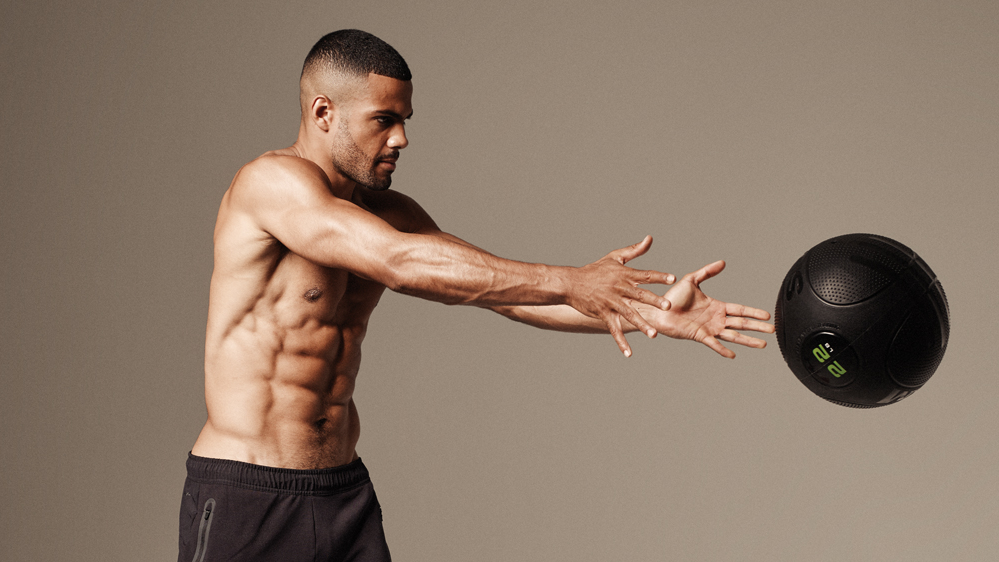
Train Smarter (And Harder)
1. Train for strength
“Don’t waste your time training to burn fat,” says Nate Miyaki, a fat loss expert and author of The 6-Pack Checklist. “Your diet gives you 80% of your fat loss results, and a small increase in ‘non-formal’ activity - walking, basically – does the rest. If transformation is your goal, you should be trying to build muscle. Strength training is the best way to do this, and should be your focus. Traditional hypertrophy training is fast and efficient: train three to five times a week, six to 20 reps per exercise, for three to eight sets per muscle group.” Simple but effective.
2. Breathe
“All core training starts with breathing,” says renowned NFL trainer Joe DeFranco. “And most people don’t know how to breathe properly.” Practise the basics now: take a deep breath through your nose, aiming to fill your belly with air. You can also download the Universal Breathing Pranayama app to improve your lung and diaphragm function. “When you first do it right,” says DeFranco, “it almost feels like conditioning.”
3. Think “anti-movement”
Once you’ve mastered the basics of breathing, work on that spine stabilisation by focusing on moves where you’re resisting movement, not starting it. Planks, isolation holds and loaded carries, where you walk with a weight in one hand, all fit the bill.
4. Add NEPA if you need it
You’ll be burning most of your fat with diet – more about this below – but for an extra boost, non-exercise physical activity (NEPA) gets results without giving you hunger spikes or causing exhaustion. “Walking gives you many of the benefits of traditional cardio without joint wear and tear, repetitive strain, testosterone suppression or increased cortisol,” says Miyaki. “It’s also convenient, and a good stress reliever. Start with a 30- to 60-minute walk on your days off strength training, and ramp up until you’re doing it daily.”
5. Brace yourself
“The main role of the core is to protect and stabilise the spine while your extremities move,” says strength coach Jack Lovett. “Picture a sprinter during the 100m – his core’s firing at maximum capacity, but his midsection isn’t moving. Learning to brace correctly during barbell lifts such as squats, presses and deadlifts will build dynamic core strength.” Before any big lift, tighten your stomach as if you’re about to take a punch, then “breathe into” the move.
Use The Direct Approach
The six moves below target every part of your core. Make them the mainstay of your sessions
6. 360 plank
With your feet on a bench or in the straps of a suspension trainer, walk your hands around in a circle, clockwise and then anti-clockwise. “You’ll gain strength and control,” says Dan Little, head of fitness at Digme Fitness. “Keep your abs braced throughout.”
Sign up for workout ideas, training advice, reviews of the latest gear and more.
7. Roll-out
A cheap ab wheel’s one of the most portable, effective training devices you can buy – if you use it properly. “The biggest mistake I see is when people’s glutes shoot up in the air first,” says trainer James Adamson. “As you roll out, extend your hips. When your hands are in front of your face, your hips should be almost fully extended.”
RECOMMENDED: Barbell Roll-Out Exercise Guide
8. Gym ball pike
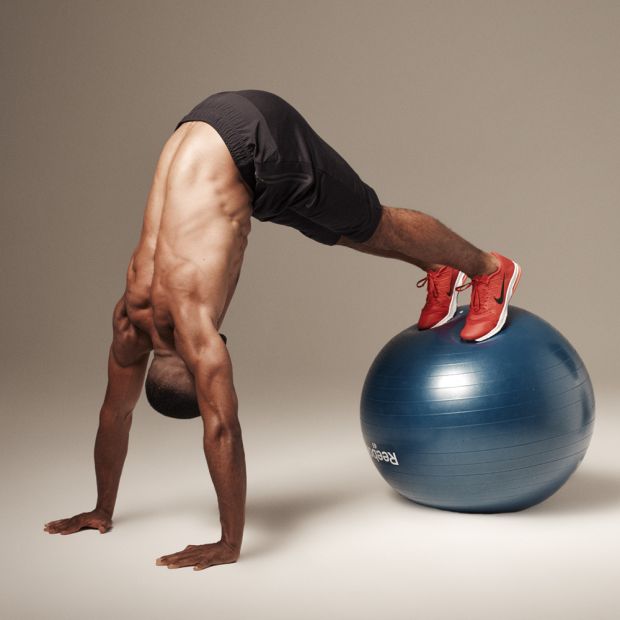
“From a press-up position, put a gym ball under your shins. Draw your knees towards your chest and lift your hips high to roll the ball towards your hands,” says Joe Spraggan, head trainer at F45’s Farringdon gym. “Lower and repeat. The instability provided by the ball stimulates more muscle fibres in your abs.”
9. Rolling 45
The Turkish get-up targets your entire core, but reps are time-consuming: bring it down to its constituent parts with the Rolling 45, suggests Little. “Lie on the floor with a kettlebell or dumbbell in one hand. Press it upward, then roll up and onto the opposite elbow. Pause, lower and repeat.” You’ll build co-ordination and strength.
10. Plank drag
Build your anti-rotational muscle strength with this plank upgrade. “Get in a plank position with a sandbag or kettlebell to one side of your body,” says Adamson. “Keeping your core braced, take one hand off the floor and lift it to the other side. Repeat as necessary.” Do it for time, and try to beat your rep count.
11. Crunch reach
This crunch variation brings new life to the old move. “Lie on your back with legs extended and arms above your head,” says Spraggan. “Raise your legs straight up and reach your arms towards your toes, lifting your upper back and squeezing the upper abs. Lower and repeat. This exercise uses a large range of movement and targets both upper and lower abs.” Keep it slow and controlled.
Reinvent The Classics
12. Add a resistance band to crunches
“Fix a resistance band to a secure point at around knee height,” says Spraggan. “Lie on your back facing away from the resistance band, taking hold of it in both hands and brace your arms and chest. Squeeze your hands and elbows towards each other and slowly lift your head and shoulders from the floor, rolling your upper spine away from the floor. Try to keep a consistent tension on the band as you engage your upper, middle and lower abs.”
13. Add weight to deadbugs
This Pilates move is tough enough unweighted, but adding resistance forces you to develop a bulletproof core. “Hold a weight plate with your arms outstretched and knees bent at 90˚ so your feet are in the air,” says Little. “Lower each leg alternately to the floor. Sounds easy, but the trick is to keep your lower back glued to the floor. It will want to come up, but strong abs will keep it rooted.”
14. Change your hand position for dragon flags
The Bruce Lee classic is much-imitated but rarely done well. Fix your form by adding a suspension trainer and using a shoulder stand. “Lie on your back with your head underneath the anchor point,” says trainer Niko Algieri. “Place your hands in the TRX arches at the bottom. Keeping your arms by your sides, perform a double leg raise until your feet come in line with your eyes and then lift directly up onto your shoulders. Reverse the move until your legs are at 45°, then repeat.” Pushing on the straps makes it slightly easier, but it’s still no joke.
15. Use the hip drop instead of side bends
“The classic dumbbell move can be mimicked on the TRX, but with more of a mobility benefit,” says Algieri. “Stand side-on to the TRX anchor point and hold one handle with both hands directly above your head. Keep a 90° bend in each elbow. Keeping the body taut, ‘break’ your hips outwards away from the TRX and then bring them back in. You’ll feel your obliques work overtime.”
16. Add a swing to knee tucks
“This is a fully gymnastic movement and less boring than the classic moves,” says Algieri. “In a TRX plank, start to pendulum-swing side to side. Each time you swing tuck your knees to the corresponding side. Don’t just go to the elbow – rotate the hips more and go outside the elbow for maximum range of motion and more abs engagement.”
17. Slow Russian twists down
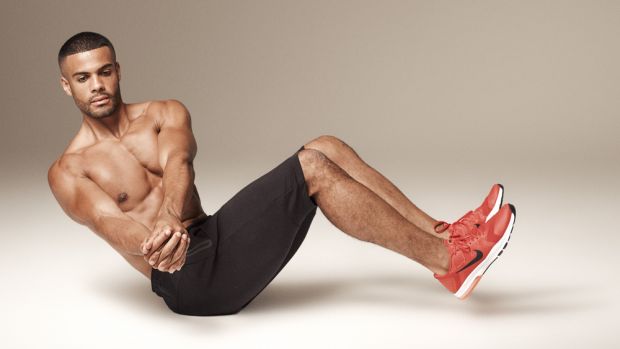
It’s one of the most effective abs moves you can do with zero kit, but 99% of people do it wrong. “You should feel your abs light up when you do it,” says Adamson. “And most people don’t need to add weight. Sit on the floor with your feet slightly raised and your body at a 45˚ angle. Keep your arms at right angles to your body, and rotate with your torso, not from your arms.” If it’s too tough, start with your feet on the floor.
18. For planks – just try harder
If you can already do a plank for two minutes, you’re at the point of diminishing returns. Improve your efficiency by changing the leverage: from the usual start position, push off your forearms to move your feet backwards, until you feel more tension. Aim for four sets of ten to 30 seconds.
Get Your Fat Loss In A Glass
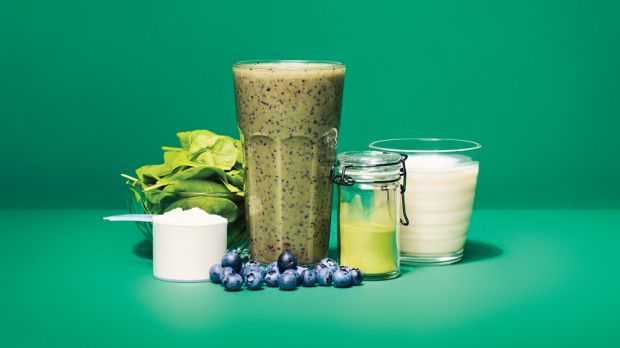
Forget the fruit-heavy smoothies – embrace these less common food combos for high-speed gains
19. Start the day right with spinach and almonds
“Always have a fruit and vegetable combo – it gives you a wider array of vitamins, minerals, phytonutrients and enzymes,” says nutritionist Rick Hay. “For a breakfast berry blast that aids fullness, blend 200ml of rice milk or almond milk and a cupful or two of fresh or frozen berries with a handful of spinach and five or six almonds.”
20. Use pineapple and matcha for better digestion
“Mix 300ml of lactose-free milk – almond works best – with 100g of chopped pineapple and one or two teaspoons of matcha powder,” says Neat Nutrition’s Lee Forster. “Pineapple contains digestive enzymes to decrease inflammation, and matcha is even higher in EGCG – a compound thought to have various health benefits – than green tea.”
21. Turn to purple cabbage and blueberries for performance
“Purple foods, like frozen berries and purple cabbage, are rich in flavonoids and antioxidants,” says holistic nutritionist Lee Holmes. “Purple cabbage is low in calories but high in dietary fibre and essential vitamins and minerals. Blueberries aid focus and concentration thanks to vitamins A, C and E.”
Stay On Target With Compound Moves
The movements below work your whole body – but keep your six-pack firing
22. Get going with the bear crawl
Use it in your warm-up to fire up your abs from the word go. Set up on your hands and knees, then bring your knees off the ground, keeping them slightly behind your hips – keeping your hips low will increase the abs activation. “Crawl” forward by moving one hand and the opposite foot, keeping your back flat.
23. Slow down your deadlift
“Done right, the deadlift is extremely effective in developing abs,” says Algieri. “It demands the core be constantly engaged so as to not round the back – but the eccentric or lowering phase is the most important part, since your abs will be working double time to stabilise your back.” Drop to around 50% of your usual max, and aim to spend up to two seconds lowering each rep.
24. Walk with a cross-over
Every loaded carry builds abs strength, but some do it better than others. For better obliques, “contralateral” movements – in which you load one side of the body – work best, forcing your abs to work overtime to stabilise the weight. The cross-over walk takes it a step further. “Walk with one kettlebell in the rack position against your forearm, and the other in your hand, like a suitcase,” says Adamson. “You’ll feel the tension run diagonally through your body.”
25. Add a press to your squat
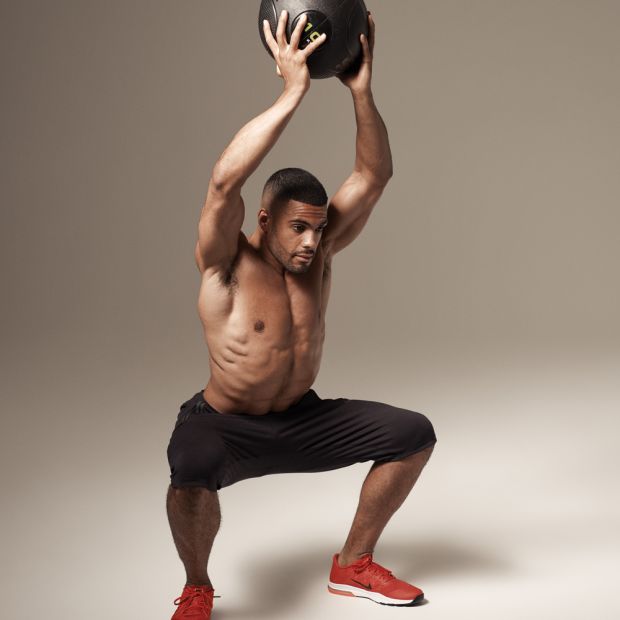
One for leg day. “Set up just like a regular squat,” says Spraggan. “ Your feet should be shoulder-width apart or a little wider, knees and toes turned out slightly. Hold a medicine ball or barbell overhead: the latter will take more flexibility. As you lower your hips, keep your arms extended and make sure your chest is up. Keep your arms locked out in the same position as you return to standing. You’ll engage your abs under real-world conditions.”
26. Lunge with a twist
“Start with your feet close together, standing tall with a medicine ball in both hands held at chest height with your arms extended,” says Spraggan. “Take a long step forward, bend your front knee and drop your back knee until it almost touches the floor. As you lower, twist your torso towards the direction of your front knee. Your arms should always be level and hands in line with the middle of your chest.”
27. Push through with the one-arm press
“Most unilateral moves incorporate some degree of core control, to stabilise the weight,” says Spraggan. “But a dumbbell chest press will do it while improving your pressing. Lie on your back on a bench, feet pressed into the ground and dumbbells extended over your chest. Lower one dumbbell towards your chest, then press back up. You should be aware of the pressure changing in your feet and core in a diagonal pattern.”
Fix Your Nutrition
You’ve done the building work – now let’s get that six-pack out in the open
28. Drink more water
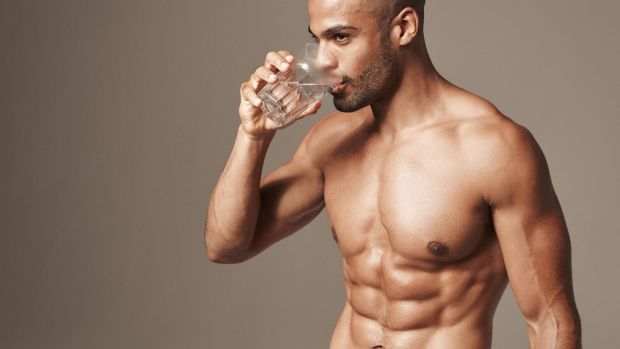
No surprises here – a 2016 review of studies found that better hydration is linked to weight loss. Researchers are still arguing about whether or not it increases fullness – and prevents bingeing – but it is definitely important to drink water so your liver can effectively metabolise body fat. Have a glass with every meal, and at least a sip alongside every hot drink.
29. Cut out hyperpalatable foods
The problem with the modern food industry? It wants you to eat more. Modern, heavily processed food is carefully designed to be delicious, combining fat, sugar, texture and taste to create a perfect storm of palatability. “Foods like this are empty calories,” says Miyaki. “That means you’ll feel constantly hungry, deprived and miserable. Cut down on refined carbs including flour and sugar, and fast foods that combine them with fat, and make natural whole foods your foundation.”
30. Emphasise high-satiety foods
“I’ve seen people struggle to net 1,800 calories a day when they cut out anything refined – including oils – and ate real food,” says Miyaki. “You don’t have to go that extreme, but it’s easy to stay in a calorie deficit while getting all the nutrients you need if you emphasise real food. My preferred method is what I call an ‘island-style diet’: like Paleo, but with root vegetables and rice to fuel and recover from training.” Eat animal proteins, whole fruit, sweet potatoes, vegetables and white rice.
31. Eat enough protein
“Adequate protein helps us preserve lean muscle mass while staying in the calorie deficit necessary for fat loss,” says Miyaki. “It’s also a high-satiety food, meaning it keeps you full.” In research from Purdue University in the US, men who ate a few protein-heavy meals felt fuller than men who ate more frequently – and also reported fewer late-night cravings and thoughts about food in general. Aim for 1.5-2g per kilo of target bodyweight, per day, split between your meals.
32. Think sustainable
“It doesn’t matter if you have the best plan in the world written down if you can’t follow it,” says Miyaki. “A sane diet structure is the key to sustainability. Three meals a day can work great for weight loss, as can feasting at night. My preferred structure is to stick to this, escalating your carbs throughout the day – but you should experiment to figure out what’s sustainable for your lifestyle.”
33. Track your macros
You don’t need to count calories for the rest of your life, but there are two good times to do it, says Miyaki: when you’re first starting out, and when you need to ramp things up. “I’ve had people realise their protein count is paltry or that they were eating 1,000 calories a day in refined oils,” he says. “You’ll see where the extra stuff sneaks in.” Use MyFitnessPal or a pen and paper with info from nutritiondata.self.com.
34. Cheat sparingly
Despite what you’ve been told, you don’t need cheat meals – at least on a biological level – until you’re heading towards the lows of sub-10% body fat. But if they work for you psychologically, keep them infrequent. Plan one to two cheat meals (not days) a week, and get rid of the bad stuff once you get up from the table.
Assess Your Cupboards
Have you got these store cupboard essentials on standby? If not, hit the shops
35. Coffee
The American Journal Of Clinical Nutrition discovered that the caffeine in coffee significantly increases fat oxidation and metabolic rate for up to three hours after your last sip. Drink it black or with a dash of cinnamon.
RECOMMENDED: The Health Benefits Of Coffee
36. Cinnamon
It adds flavour to coffee (or, if you’re feeling ambitious, combines with lime juice and turmeric for a solid marinade) without a calorie hit, and stabilises your insulin levels. Fresh is better.
37. Cayenne pepper
Use it to spice up chilli or sweet potato fries: according to a study published in Physiology And Behavior, it’ll curb appetite and prompt your body to burn calories.
38. Ginger
Keep the powder on hand or blend the fresh stuff into a shake. Research published in the Journal Of Exercise Science & Fitness found that a teaspoonful of it daily helped men cut an average of 4.1kg of body fat over ten weeks when combined with strength training.
39. Black pepper
Add it to eggs, veg, and everything else – a study published in the Journal Of Agricultural And Food Chemistry showed that piperine, the stuff that gives pepper its pungency, can stop the formation of new fat cells.
40. Green tea
Keep it in the cupboard: a compound known as EGCG makes it slightly superior to the black stuff for fat metabolism – plus you can make it with lemon instead of milk for an insulin-stabilising taste hit.
41. Dark chocolate
It’s the best sweet treat to keep in the fridge: plant-based nutrients known as flavanols – more prevalent in the 80% cocoa stuff – help to lower blood sugar and control cravings, while the intense flavours mean one square is enough.
42. Black beans
Keep a can or two in the cupboard because they’re a rich source of plant protein and fibre, promoting fullness and fat loss.
Choose Life(style Changes)
There are 168 hours in a week. Make sure you’re not undoing your good work from the four you’re in the gym
43. Address stress
“Keep calm” isn’t the easiest advice to follow in these troubled times, but it’ll address the build-up of cortisol, making digestion easier and sleep better. Make an “anxiety list’ of stuff that’s worrying you, cross off the stuff you can’t control, then take the first step towards fixing the rest.
44. Sleep more
Going without enough shut-eye lowers levels of the satiety hormone leptin, according to research from the Journal Of Clinical Endocrinology & Metabolism. Download the F.Lux app for all your devices to remove the blue light seeping from your screens at night, which is thought to help you rest easier.
RECOMMENDED: How To Sleep Better
45. Create routines
Better habits will make fat loss automatic – and your abs will follow. Psychologist David Neal suggests disrupting your current “bad” routines (changing your Starbucks-heavy route to work, for instance) as a starting point to making better ones.
46. Purge your kitchen
According to research conducted by Cornell University in the US, when volunteers removed TVs and comfy seating from their kitchens, they spent 18 fewer minutes there each day. You don’t have to go full Spartan, but leave your phone and iPad in another room when you eat.
47. Keep bad stuff out of sight
The simplest fix you can make: keep veg and fruit on display and bad stuff – snack bars, cereal, sweets – out of your field of vision. Research suggests you’re making a mini-decision every time you research the urge to snack, so take that decision out of your hands – and switching will come easy.
RECOMMENDED: The Healthy Late-Night Snacks Personal Trainers Eat
Add Some Supplements
They can’t do the work, but they will provide the finishing touches. Choose wisely
48. Fish oil
Having a solid omega 3:6 ratio isn’t just important for health – it’s also a key part of insulin sensitivity, which is fundamental to fat loss. Take fish oil at least once a day with food.
49. L-carnitine
L-carnitine plays many roles in the body, specifically in helping to use fat stores as fuel. You don’t need it unless you’re deficient: but if you’re dieting hard, it’s worth topping up.
50. Creatine
It helps back up your body’s stores of ATP, the fuel source for your highest-intensity efforts. If you’re in a serious strength training phase, take 5g a day alongside at least 500ml of water.
Photography: Glen Burrows. Model: Lee McLaughlin
From 2008 to 2018, Joel worked for Men's Fitness, which predated, and then shared a website with, Coach. Though he spent years running the hills of Bath, he’s since ditched his trainers for a succession of Converse high-tops, since they’re better suited to his love of pulling vans, lifting cars, and hefting logs in a succession of strongman competitions.

